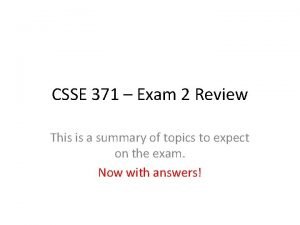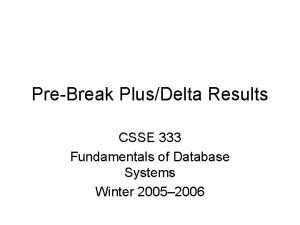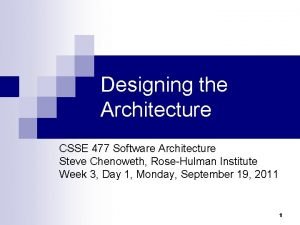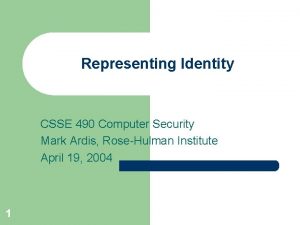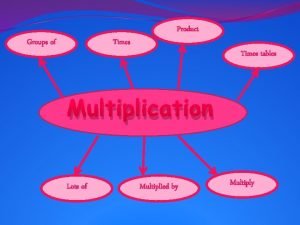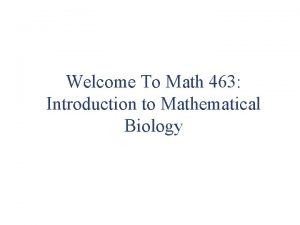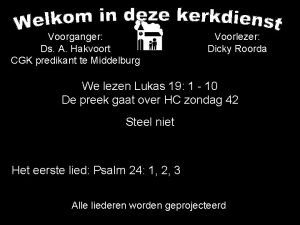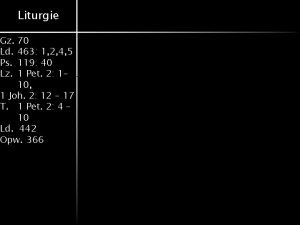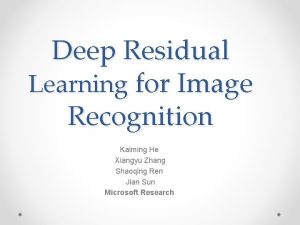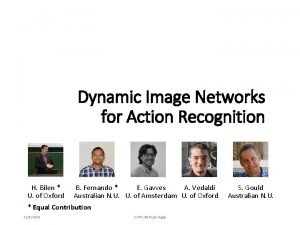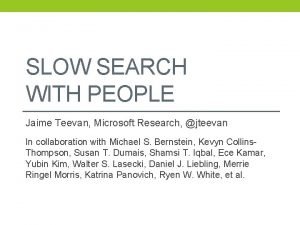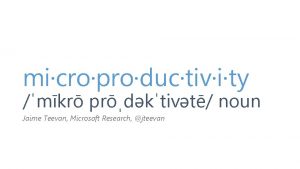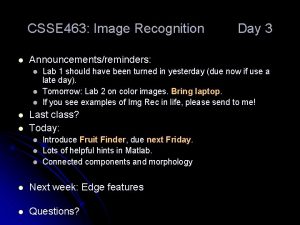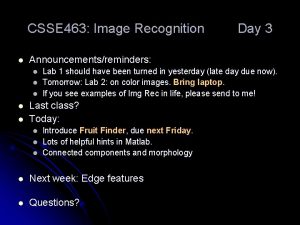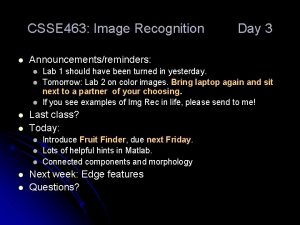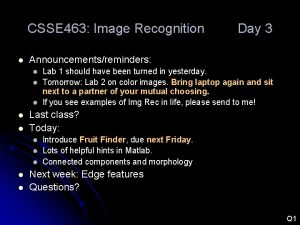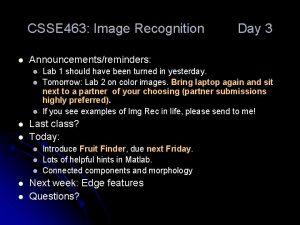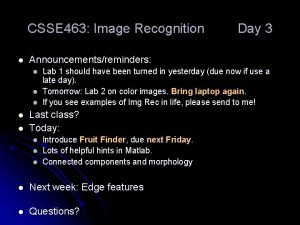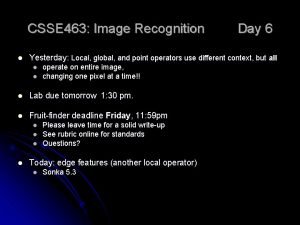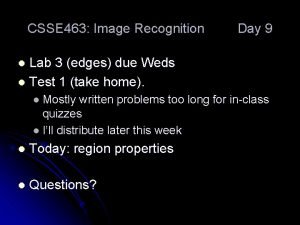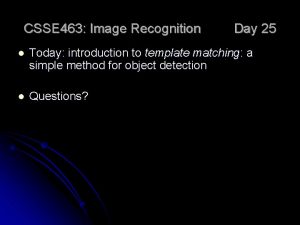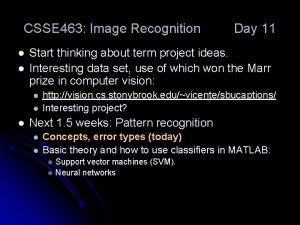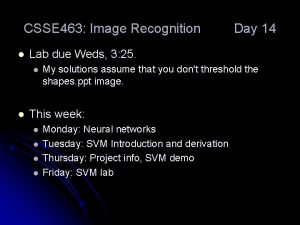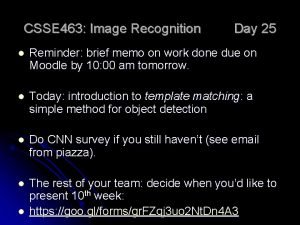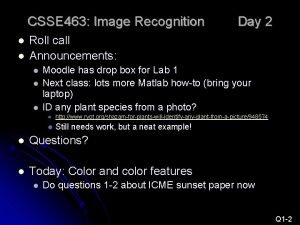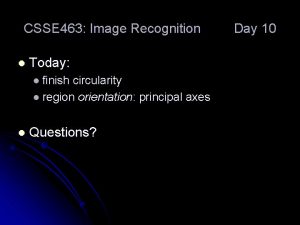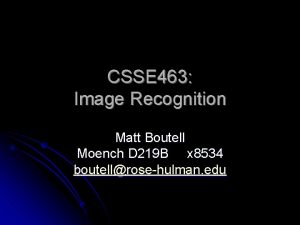CSSE 463 Image Recognition l Announcementsreminders l l

















- Slides: 17

CSSE 463: Image Recognition l Announcements/reminders: l l l l Lab 1 should have been turned in yesterday (due now if use a late day). 2 early, 2 late, all others on time. Tomorrow: Lab 2 on color images. Bring laptop again and sit next to your partner. If you see examples of Img Rec in life, please send to me! Last class? Today: l l Day 3 Introduce Fruit Finder, due next Friday. Lots of helpful hints in Matlab. Connected components and morphology Next week: Edge features Questions?

Spatial component of color l Break image into parts and describe each one l l Regular grid l l l Can describe each part with moments or histograms Pros? Cons? Image regions l l Pros? Cons? Q 9

Project 1: Counting Fruit l How many apples? bananas? oranges?

Why the fruit-finder? l Crash-course in using and applying Matlab l l l For this reason, I will direct you to some useful functions, but will not give details of all of them Practice feature extraction Practice writing a conference-paper style report l l l Formal and professional! Use style similar to ICME sunset paper (Abstract, Introduction, Process, Results, …) Lots of details in specification and rubric.

Fruit-finding technique l Observe l l Model l l Can you differentiate between yellow and orange? Orange and red? (Decisions) Note: this isn’t using a classifier yet; just our best guess at handtuned boundaries Classify pixels using your model (today’s how-to) “Clean up” the results l l What numbers define a banana’s “yellow”? (using imtool pixel zoom) Mathematical morphology: today’s discussion! Write up your results in a professional report (as you go)

Region processing l Binary image analysis l Today, we’ll only consider binary images composed of foreground and background regions l Example: apple and non-apple l Use find to create a mask of which pixels belong to each Q 1

Matlab How-to create a mask l Lots of “Random” tidbits that I used in my solution: l zeros l size l find Q 2 -3

Modifying the mask requires us to define which pixels are neighbors

Neighborhoods l Do we consider diagonals or not? l 4 -neighborhood of pixel p: l Consists of pixels in the 4 primary compass directions from p. l 8 -neighborhood of pixel p: l Adds 4 pixels in the 4 secondary compass directions from p. Q 4 -5

Morphological operations (Sonka, ch 13) Morphology = form and structure (shape) l For binary images l l Done via a structuring element (usually a rectangle or circle) l Basic operations: l Dilation, erosion, closing, opening

Dilation l Given a structuring element, adds points in the union of the structuring element and the mask l Intuition: Adds background pixels adjacent to the boundary of the foreground region to the foreground. l Def, for image X and structuring element B: Q 7 a

Dilation in action Strel = 2 x 1, centered on dot

Dilation l Matlab: imdilate(bw, structure. Elt) l l Typically want symmetric structuring elements structure. Elt (for 8 neighborhood) found by: l l structure. Elt = strel(‘square’, 3); % for erosion using 3 x 3 neighborhood structure. Elt (for 4 neighborhood) found by: l structure. Elt = strel([0 1 0; 1 1 1; 0 1 0]); l strel lists 11 others Demo for intuition: Enlarges a region l Def: l help Q 7 a

Erosion Removes all pixels on the boundary l Matlab: imerode(bw, structure. Elt) l Q 7 b

Closing and Opening l Closing (imclose) l l Opening (imopen) l l Dilate, then erode Fills internal holes in a region, while maintaining approximate pixel count Eliminates inlets on the boundary erode, then dilate Removes small regions Eliminates peninsulas on the boundary To make dilation more aggressive, l l l Dilate n times, then erode n times. Or, use a larger structuring element Example: compare dilating twice using a 3 x 3 square with dilating once using a 5 x 5 square.

Connected Components l Goal: to label groups of connected pixels. l Assign each block of foreground pixels a unique integer l 4 -connectivity vs. 8 -connectivity matters Matlab help: search for connected components, and use bwlabel function l Demo l I may have you devise an algorithm to do this as part of week 3 take-home test. l Q 6

Lab 2 l l What format? See nice lab 1 You will work with a partner for each lab l l l Can stay same or change I have posted a simpler 10 -point grading rubric at the top of each lab Please ask questions and complete as much as you can in class Each lab is due the following Weds at the same time as the start of class Start now!
 Csse exam
Csse exam Csse results
Csse results Csse quiz server
Csse quiz server Representing identity in information security
Representing identity in information security 463 x 12
463 x 12 Math 463
Math 463 Liedboek 463
Liedboek 463 Https//gcbger.nv.gov/regapp
Https//gcbger.nv.gov/regapp Lied 463
Lied 463 Xkcd artificial intelligence
Xkcd artificial intelligence He kaiming
He kaiming Dynamic image networks for action recognition
Dynamic image networks for action recognition Text recognition image
Text recognition image Microproductivity
Microproductivity Exploring self-attention for image recognition.
Exploring self-attention for image recognition. E
E Image geometry in digital image processing
Image geometry in digital image processing What is image restoration in digital image processing
What is image restoration in digital image processing
